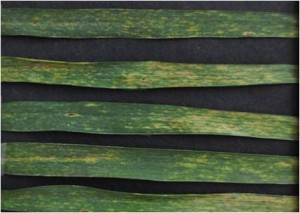When Scouting Winter Wheat, Keep in Mind Physiological Leaf Spot
What might look like tan spot or septoria on winter wheat could be physiological leaf spot (PLS). Diagnosis of PLS can be difficult as there are a variety of symptoms. Often, it is diagnosed in hindsight, i.e. my fungicide didn’t work. However, proper diagnosis is important as it could prevent unnecessary fungicide applications.
How to distinguish the symptoms of PLS from leaf spot diseases:
Physiological leaf spot symptoms start as small yellow necrotic spots (one to three mm) on the upper leaves. As they develop, a dark brown center forms in this necrotic spot, which is similar to tan spot. However, physiological leaf spots are usually more “blocky” or “angular” and are often defined by the leaf veins. Tan spot lesions are more oval or elliptical and often have a yellow halo surrounding the necrotic (dead) spot. This is more evident as the lesions expand.

Physiological Leaf Spot (MAFRD Crop Diagnostic Lab, 2010)
Plant diseases can be cultured and identified at the Crop Diagnostic Centre in Winnipeg. However, this isn’t the best route for confirming physiological leaf spot as it does so through the process of elimination, i.e. absence of a pathogenic organism. Regardless of how PLS is confirmed, confirmation should be performed on a field-by-field basis. And remember that both PLS and leaf disease may actually occur on the same leaves.
Additional comments on PLS:
- PLS is strongly related to genetic predisposition and only appears in certain environmental conditions.
- CDC Falcon, which is a popular winter wheat variety in Manitoba, is very susceptible. However, all varieties can exhibit symptoms of PLS.
- PLS is favoured by cool, wet spring and summer conditions that promote vigorous plant growth. Rainy days in combination with sunny, warm days can also favour it.
- PLS can be associated with low chloride levels in the plant and soil.
- PLS is not reduced by fungicide applications.
